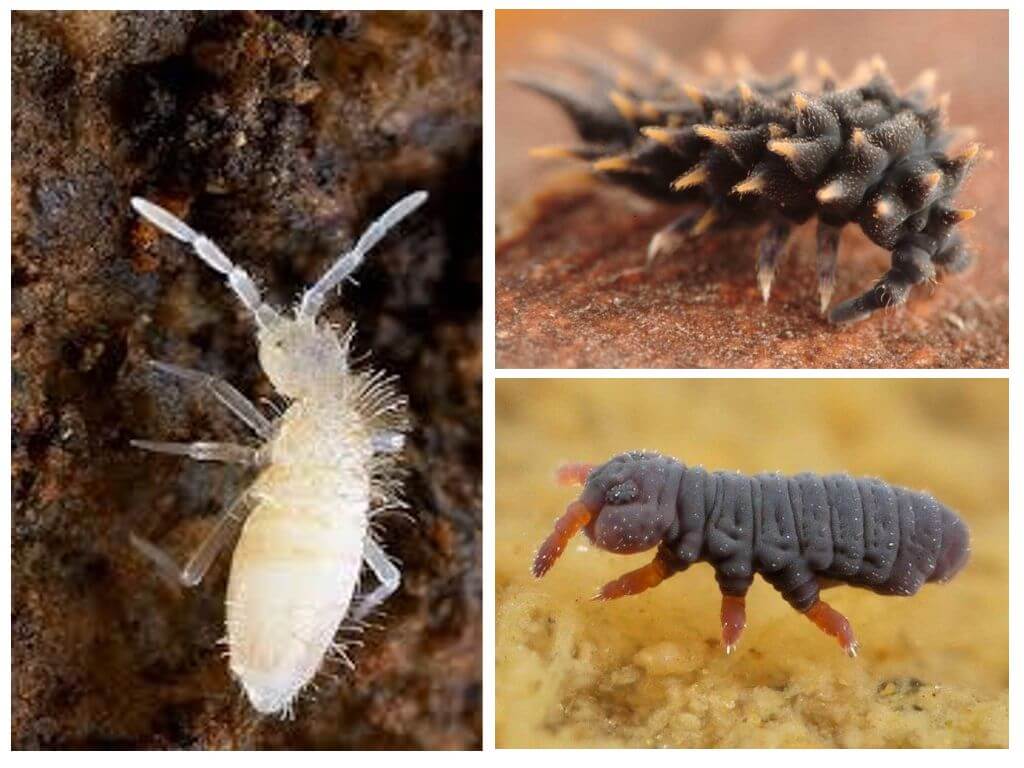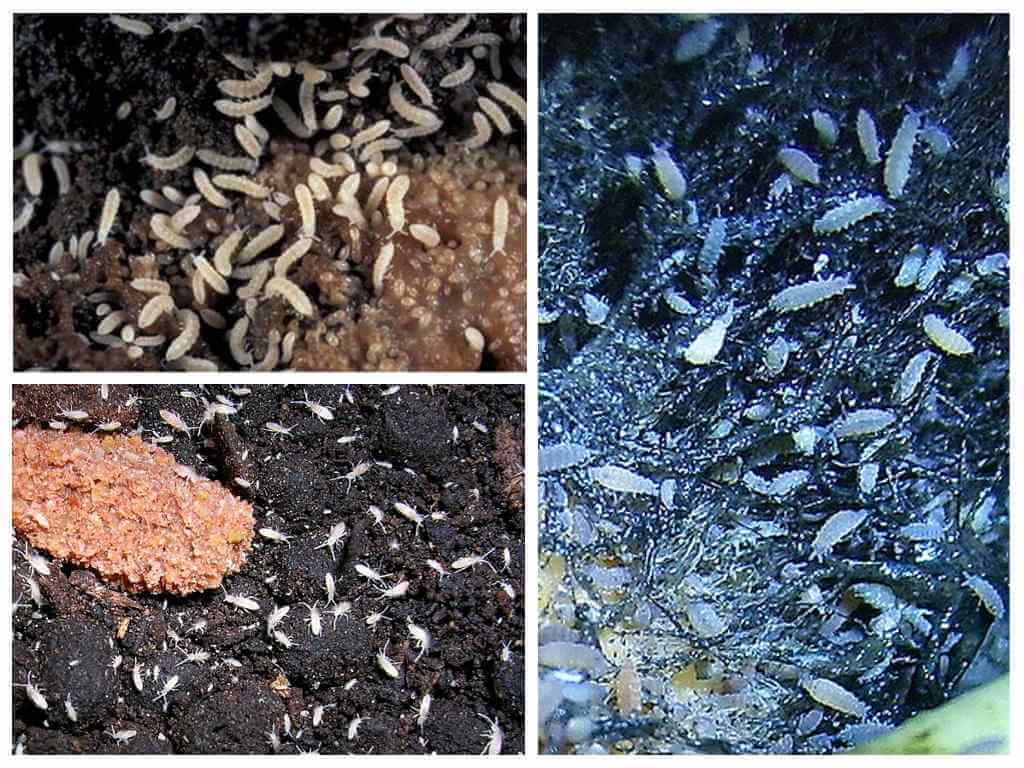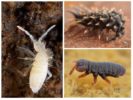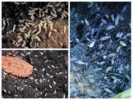- Fools
- Nailtails in flowers
- Camellia, Gardenia and Azalea
- Means Bazudin
Nailtails are small pests that many gardeners have encountered. Collembolans or podura, as they are also called by the people, usually live in flower pots. Such an insect prefers to settle in the upper layers of the soil, where there is increased humidity. After all, it is excessive watering that causes the appearance of the springtail. A small cluster of podur will not do much harm to the plant. However, a rapid increase in the population can lead to damage to the root system of the planting, the consequence of which is its slow growth and even death.
What a fool looks like
Colembula is a small insect whose body size is from 2 to 10 mm. Outwardly, it is very similar to a caterpillar painted in white or beige. There are also yellow tails or podura yellow, gray and even metallic shades, with transverse stripes, marble or dotted pattern.
On the underside of the abdomen, the collembola has a fork-shaped process, thanks to which it not only moves along the soil, but also is able to jump. In a calm state, this jumping body bends under the abdomen and is practically invisible. This is the most obvious sign with which even a beginner grower can recognize a podura. Below is a photo of the tails.
Conditionally, the tails are divided into the following species:
- white women - pests that live in the upper layers of the soil, especially often they can be found in greenhouses and greenhouses, where the humidity level is high;
- vegetable soups - insects eating decorative plantings, they are also inhabitants of suburban areas;
- mushroom podura - This type of pest can harm young shoots, seedlings and bulbous flowers.
Photos of various species of podur can be seen below.

On a note!
The number of springtails largely depends on the level of humidity: the higher it is, the faster the pests multiply. From the eggs laid by the female into the substrate over time, larvae appear that differ from adults only in size.
Ways of penetration of fools
Many amateur gardeners who have encountered such a problem are puzzled by the question of how the collembolans could get into pots with indoor plants. Pests can infiltrate:
- through vents;
- on a new plant, the soil of which is already infected with footstails;
- with poorly processed substrate.
Symptoms of infection
You can verify the presence of springtails on indoor flowers by the following signs.
- White plaque on the ground is evidence of its excessive moisture, and therefore a favorable factor for the presence of podura.
- Active movement of nails in the ground.
- With a large accumulation of insects, damage is possible not only to the root system, but also to the upper sections of the stems.
Causes of occurrence

Nail tails in indoor flowers settle only when there is a favorable environment for their habitation. Usually a fool entails:
- excessively moist soil, excessive irrigation and poorly equipped drainage system are some of the important reasons for the appearance of springtails;
- damp air in the room or greenhouse;
- the presence of moss;
- excessive use of organic fertilizers;
- rotting residues of natural fertilizers, tea brewing in combination with stagnant water in the soil or pan is of particular danger;
- low temperature in the room.
Mechanical methods of struggle
Poor care, accumulations of dried leaves and excess moisture create ideal conditions for wound-ups in indoor plants. Therefore, to eliminate pests, it is necessary, first of all, to regulate irrigation, which is the main cause of increased soil moisture. Deprived of habitual and comfortable living conditions, the tails will no longer bother the plant.
There are other ways to get rid of a fool:
- It is very important to comply with humidity indicators in the room. To do this, you should often air the room, dry the laundry outdoors, and also provide access to sunlight. Adjust the moisture level will help a special device that absorbs excess moisture.
- Sprinkling soil with ash or sand is one of the most effective methods of destroying podura. It can be used for almost all plantings. The exception is plants growing in acidic soil. These include camellia, gardenia or azalea.
Camellia, Gardenia and Azalea - To get rid of pests, just put a pot of plants in the water. After that, on its surface, it remains only to collect the emerged nails.
- Particular attention should be paid to the drainage system. After all, it is precisely the clogging of the holes available at the bottom of the flower pot that causes stagnation of water. Several pebbles that are laid on the bottom of the pot during a flower transplant will help to avoid this.
- Substitution of the substrate is another effective method that allows you to get rid of the nailtail. It is important not only to remove contaminated soil, but also thoroughly rinse the root system.
- Organic fertilizers should not be used too often. The remains of tea leaves or ground coffee can cause the development of mold or fungus, so they are added to the soil no more than 1 time per week. After 2-3 days, particles of organics are removed and the soil is loosened up gently so that the soil is enriched with oxygen. It is important to exclude all factors that contribute to rotting and moldiness of the soil.
- There is another original folk way to get rid of podur, which is safe, both for the plant and for the person himself. To do this, you need raw potatoes, which are cut into two parts, each of which is laid down on a substrate with a slice down. Raising these halves after a few hours, you can see many pests on them. Then the fool should be brushed off or washed off with water and the “bait” should be reinstalled.
The use of chemical preparations in the fight against foolishness
If you can’t get rid of the larvae and adult podura that live in the roots of plants using the above methods, you should use chemical preparations. They are able to cope with parasites in a short time. When using insecticides, strict observance of safety measures is necessary. You should also protect the access of small children and pets to the treated plant.

One of the effective drugs against podura is Bazudin. A powdery substance is scattered on the soil, after a few hours the collembolans will not annoy the plant. No less effective is Pochin - a drug of a similar method of use. To speed up the process, granules scattered over the surface of the soil are slightly mixed with the ground.
On a note!
There are also universal remedies for combating stomata, from which solutions are prepared. An example of this may be Aktara or Mospilan. The solution is prepared and used in accordance with the recommendations set forth in the description.
Do not panic if podura are found in the flower pot.It’s not so difficult to get rid of a nailstail. The main thing is to detect pests in time and take appropriate measures, observing the rules of irrigation and high-quality drainage.








